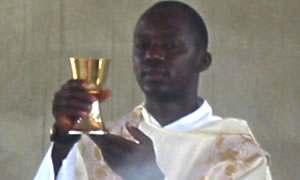


 Despite widespread appearance to the contrary, receiving Holy Communion on the tongue while kneeling is still the universal norm for the Catholic Church.
Despite widespread appearance to the contrary, receiving Holy Communion on the tongue while kneeling is still the universal norm for the Catholic Church.
True, most of us who grew up in the 70s or 80s were told otherwise, but since when has catechesis from those years been considered accurate?
For centuries Catholics had received Holy Communion on the tongue while kneeling.
There was no popular uprising to change the practice, but in the 60s some dissident leaders in Europe and the United States took it upon themselves to do so, pushing the practice of taking Holy Communion in the hand.
In Memoriale Domini, an instruction from the Sacred Congregation for Divine Worship released in 1969, we are told that “in certain communities...this practice [of taking Holy Communion in the hand] has been introduced without prior approval having been requested of the Holy See, and, at times, without any attempt to prepare the faithful adequately.”
Pope Paul VI had asked the world’s bishops the following questions:
1. Do you think that attention should be paid to the desire that, over and above the traditional manner [of receiving Holy Communion], the rite of receiving Holy Communion on the hand should be admitted?
2. Is it your wish that this new rite be first tried in small communities, with the consent of the bishop?
3. Do you think that the faithful will receive this new rite gladly, after a proper catechetical preparation?
The responses from the bishops were overwhelmingly negative. A clear majority of the episcopate reaffirmed the traditional practice and rejected the novel practice out of hand, so to speak. The traditional practice of receiving Holy Communion on the tongue while kneeling was reaffirmed by the Holy See in the following words:
From the returns it is clear that the vast majority of bishops believe that the present discipline should not be changed, and that if it were, the change would be offensive to the sentiments and the spiritual culture of these bishops and of many of the faithful.
Therefore, taking into account the remarks and the advice of those whom “the Holy Spirit has placed to rule over” the Churches [Acts 20:28], in view of the gravity of the matter and the force of the arguments put forward, the Holy Father has decided not to change the existing way of administering Holy Communion to the faithful.
It is explained further that
A change in a matter of such moment, based on a most ancient and venerable tradition, does not merely affect discipline. It carries certain dangers with it which may arise from the new manner of administering Holy Communion: the danger of a loss of reverence for the august sacrament of the altar, of profanation, of adulterating the true doctrine.
Additionally, the traditional manner of receiving Holy Communion was promoted in the instruction, “not merely because it has many centuries of tradition behind it, but especially because it expresses the faithful’s reverence for the Eucharist.”
In Memoriale Domini we have an enthusiastic endorsement of the traditional practice, along with a grave warning about the inherent dangers of the novel practice, and yet the novel practice became commonplace. This perplexing fact was due in part to the possibility of a tenuous permission—but not promotion—in the instruction:
Where a contrary usage, that of placing Holy Communion on the hand, prevails, the Holy See—wishing to help them fulfill their task, often difficult as it is nowadays—lays on those conferences the task of weighing carefully whatever special circumstances may exist there, taking care to avoid any risk of lack of respect or of false opinions with regard to the Blessed Eucharist, and to avoid any other ill effects that may follow...
The Holy See will examine each case carefully, taking into account the links between the different local churches and between each of them and the Universal Church, in order to promote the common good and the edification of all, and that mutual good example may increase faith and piety.
How the possibility of official (though reluctant) allowance for a practice backed by dissidents would promote the common good or increase faith and piety is a great mystery indeed. In point of fact, the eventual allowance for the novel practice did not promote the common good and did not increase faith or piety. Quite the opposite occurred, as the Church witnessed an almost wholesale destruction of these virtues in the 70s and 80s.
The widespread practice of taking Holy Communion in the hand coincided with (or led to) a great number of Catholics no longer believing in the Real Presence, and with a metaphorical taking of the Faith into one’s own hands. In other words, each one of the faithful was thought to be able to change the Church’s doctrines into whatever suited him.
This is not what Pope Paul VI wanted, yet it is what occurred. What he wanted, as expressed in his encyclical Mysterium Fidei, released in 1965, is that the Church continue to collectively adore Our Lord in the Holy Eucharist:
[T]he Catholic Church has held firm to this belief in the presence of Christ’s Body and Blood in the Eucharist not only in her teaching but in her life as well, since she has at all times paid this great Sacrament the worship known as latria, which may be given to God alone. As St. Augustine says: “It was in His flesh that Christ walked among us and it is His flesh that He has given us to eat for our salvation; but no one eats of this flesh without having first adored it . . . and not only do we not sin in thus adoring it, but we would be sinning if we did not do so.” (No. 55)
Since taking Holy Communion in the hand carries with it many dangers, and since receiving Our Lord on the tongue while kneeling expresses reverence, why don’t we all receive on the tongue while kneeling? This manner of reception is still the universal norm for the Church, so we are all perfectly free to make use of it. Outside of physical incapability of kneeling and getting back up without pain or commotion, why would anyone who wants to show reverence do anything but employ the traditional practice?


I have been thinking a great deal about my experience at Reconciliation this past Saturday. I felt an intense and unexplainable urge to go and confess my sins when I woke up that morning. I try to go every six weeks or so, but this was no routine visit to the priest for me. I needed to unburden myself of the numerous venial sins I had committed since I last participated in this Sacrament.
Purest Gold: God's Refining Fire in our Lives »
After salvation, many young Christians wonder if there's anything more to their newfound faith than just the security blanket of "being a Christian." Time and time again, God shows himself as a "refiner," and our lives are as gold. God started leading me in this study to understand what He was doing in my life, as well as in the lives of others.
Picking up my pen to write this column, I couldn’t imagine how time flies. Since the last publication of this column I have gone through a lot, especially the loss of my dear mother to whom I dedicate this article. Not only her, but seems I lost a whole generation of my close family.
How to Achieve Business Excellence »
“Do you see a man who excels in his work? He will stand before Kings; He will not stand before unknown men.” Proverbs 22:29
Spiritual Development for our Youth »
Most of us youth in today's fast moving world are easily thrown off by difficulties and worries.
The theme of conversion is a thread that runs all through Lent, but conversion takes on different aspects throughout the phases of Lent. The first two and a half weeks focused on the interior turning of hearts; the liturgy urges the faithful to reflect and examine consciences thoroughly.
Saint Josephine Bakhita »
Feast Day: February 8
Patron Saint Of: Sudan
Saint Josephine Margaret Bakhita was born around 1869 in the village of Olgossa in the Darfur region of Sudan. She was a member of the Daju people and her uncle was a tribal chief. Due to her family lineage, she grew up happy and relatively prosperous, saying that as a child, she did not know suffering.
Catholics Must Fast More Intensely This Lent»
The Norbertine Canons of St. Michael's Abbey have created this digital Lenten retreat so that you can journey through this holy season alongside them. If you want to have one of your best Lenten seasons yet, join us in our Lenten Program "The Great Fast" - https://theabbotscircle.com/the-great-fast-join
When Your Faith Is Put to the Test - Bishop Barron's Sunday Sermon»
Friends, we come now to the Second Sunday of Lent, and we’re on both dangerous and very holy ground with the first reading from the twenty-second chapter of Genesis. The ancient Israelites referred to it as the “Akedah,” which means the “binding”: Abraham binds and is ready to sacrifice Isaac at God’s command.

Copyright © 2002-2024 THE BEACON INTERNATIONAL CATHOLIC MAGAZINE. All rights reserved.
another mc.rufus interactive web design